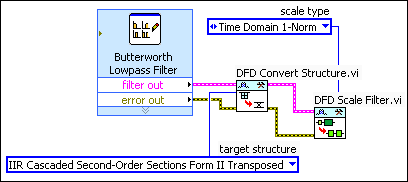Designing a Fixed-Point Filter Part 2: Scaling Filter Coefficients (Digital Filter Design Toolkit)
In Part 1 of this tutorial, you selected a filter structure for the reference floating-point filter. In Part 2 of this tutorial, you scale the coefficients of the filter.
Every filter structure contains accumulators, which might use different data ranges. In this situation, scaling the coefficients of the reference floating-point filter modifies the accumulators to use the same data range and can help you obtain a better filtering result.
 |
Note If you did not complete Part 1 of this tutorial, refer to labview\examples\Digital Filter Design\Getting Started\Tutorials\Designing a Fixed-Point Filter\Designing a Fixed-Point Filter Part 1.vi for a completed version of the digital filter from that part. |
Complete the following steps to scale the coefficients of the reference floating-point filter by using the DFD Scale Filter VI.
- Place the DFD Scale Filter VI on the block diagram.
 Place
Place
 Find
Find
- Wire the filter out and error out outputs of the DFD Convert Structure VI to the filter in and error in inputs of the DFD Scale Filter VI.
- Right-click the scale type input of the DFD Scale Filter VI and select Create»Constant from the shortcut menu.
A block diagram constant appears above the DFD Scale Filter VI. This constant represents the scale type that this VI uses to scale the filter coefficients. - Click the scale type constant to select the scale type this VI uses to scale the filter coefficients.

Note This tutorial uses Time Domain 1-Norm, the default scale type.
The block diagram now resembles the following figure.
- Select File»Save to save the VI.
After you scale the filter coefficients, you can quantize the coefficients of the reference floating-point filter in Part 3 of this tutorial.
 |
Note Refer to labview\examples\Digital Filter Design\Getting Started\Tutorials\Designing a Fixed-Point Filter\Designing a Fixed-Point Filter Part 2.vi for a completed version of the digital filter from this part of the tutorial. |
| Previous: Selecting a Filter Structure | Next: Quantizing a Floating-Point Filter |